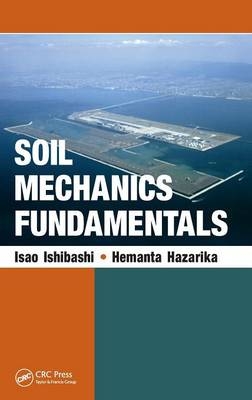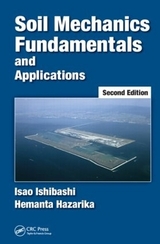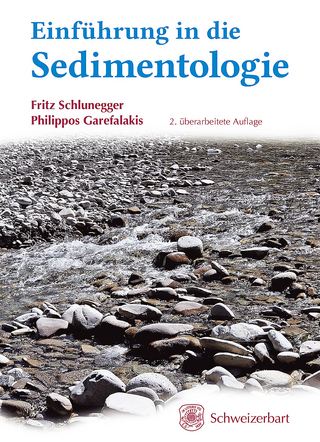
Soil Mechanics Fundamentals
Crc Press Inc (Verlag)
978-1-4398-4644-5 (ISBN)
- Titel erscheint in neuer Auflage
- Artikel merken
While many introductory texts on soil mechanics are available, most are either lacking in their explanations of soil behavior or provide far too much information without cogent organization. More significantly, few of those texts go beyond memorization of equations and numbers to provide a practical understanding of why and how soil mechanics work.
Based on the authors’ more than 25 years of teaching soil mechanics to engineering students, Soil Mechanics Fundamentals presents a comprehensive introduction to soil mechanics, with emphasis on the engineering significance of what soil is, how it behaves, and why it behaves that way. Concise, yet thorough, the text is organized incrementally, with earlier sections serving as the foundation for more advanced topics. Explaining the varied behavior of soils through mathematics, physics and chemistry, the text covers:
Engineering behavior of clays
Unified and AASHTO soil classification systems
Compaction techniques, water flow and effective stress
Stress increments in soil mass and settlement problems
Mohr’s Circle application to soil mechanics and shear strength
Lateral earth pressure and bearing capacity theories
Each chapter is accompanied by example and practicing problems that encourage readers to apply learned concepts to applications with a full understanding of soil behavior fundamentals. With this text, engineering professionals as well as students can confidently determine logical and innovative solutions to challenging situations.
Dr. Isao Ishibashi is a professor in the Department of Civil and Environmental Engineering, Old Dominion University, Norfolk, Virginia. He was born in Japan, where he obtained his bachelor and master degrees from Nagoya University. After earning his Ph.D. from the University of Washington in Seattle, he served as a faculty member at the University of Washington and Cornell University, before moving to Old Dominion in 1986. Professor Ishibashi has been involved in research in the areas of geotechnical and earthquake engineering, specifically soil liquefaction, dynamic soil properties, static and dynamic earth pressures as well as seismic water pressure, granular mechanics, slope stability, and used tire application to embankment, etc. He is the author or co-author of over 100 published technical papers that have appeared in journals and proceedings in these areas. He is a member of the ASCE, ISSMFE, ASTM, EERI, and JGS. Dr. Hemanta Hazarika is professor in the Department of Civil and Structural Engineering, Kyushu University, Fukuoka, Japan. Born in India, he obtained his bachelor of technology degree in Civil Engineering from the Indian Institute of Technology (IIT), Madras, India and his Ph. D. in Geotechnical Engineering from Nagoya University in Japan. Before moving to his present position, he worked as a practicing engineer for a few years and spent several years teaching and conducting research in academia, as well as with public sector research institutes in Japan. Professor Hazarika’s research activities include soil-structure interaction, seismic stability of soil-structure, ground improvement geosystem, applications involving recycled waste and lightweight geomaterials, stability of cut slopes, and landslides and protection against them. He has published more than 100 technical papers in international journals and for international conferences and symposia proceedings, several of which have appeared as contributed chapters in books. He is also credited with serving as the editor of two books in his research fields. He is a member of ASCE, ISSMGE, IACMAG, IGS, JSCE, and JGS.
Preface
The Authors
1. Introduction
Soil Mechanics and Related Fields
Dr. Karl von Terzaghi
Uniqueness of Soils
Approaches to Soil Mechanics Problems
Examples of Soil Mechanics Problems
Organization of Contents
References
2. Physical Properties of Soils
Introduction
Origin of Soils
Soil Particle Shapes
Definitions of Terms with Three-Phase Diagram
Particle Size and Gradation
Summary
References
Problems
3. Clays and Their Behavior
Introduction
Clay Minerals
Clay Shapes and Surface Areas
Surface Charge of Clay Particles
Clay–Water System.
Interaction of Clay Particles.
Clay Structures
Atterberg Limits and Indices
Activity
Swelling and Shrinkage of Clays
Sensitivity and Quick Clay
Clay versus Sand
Summary
References
Problems4. Soil Classification
Introduction
Unified Soil Classification System (USCS)
AASHTO Classification System
Summary
References
Problems
5. Compaction
Introduction
Relative Density
Laboratory Compaction Test
Specification of Compaction in the Field
Field Compaction Methods
Field Density Determinations
California Bearing Ratio (CBR) Test
Summary
References
Problems
6. Flow of Water through Soils
Introduction
Hydraulic Heads and Water Flow
Darcy’s Equation
Coefficient of Permeability
Laboratory Determination of Coefficient of Permeability
Field Determination of Coefficient of Permeability
Flow Net
Boundary Water Pressures
Summary
References
Problems
7. Effective Stress
Introduction
Total Stress versus Effective Stress
Effective Stress Computations in Soil Mass
Effective Stress Change due to Water Table Change
Capillary Rise and Effective Stress
Effective Stress with Water Flow
Quicksand (Sand Boiling)
Heave of Clay due to Excavation
Summary
References
Problems
8. Stress Increments in Soil Mass
Introduction
2:1 Approximate Slope Method
Vertical Stress Increment due to a Point Load
Vertical Stress Increment due to a Line Load
Vertical Stress Increment due to a Strip Load
Vertical Stress Increment under a Circular Footing
Vertical Stress Increment under an Embankment Load
Vertical Stress Increment under Corner of Rectangular Footing
Vertical Stress Increment under Irregularly Shaped Footing
Summary
References
Problems
9. Settlements
Introduction
Elastic Settlements
Primary Consolidation Settlement
One-Dimensional Primary Consolidation Model
Terzaghi’s Consolidation Theory
Laboratory Consolidation Test
Determination of Cv
e-log σ Curve Normally Consolidated and Overconsolidated Soils
Final Consolidation Settlement for Thin Clay Layer
Consolidation Settlement for Multilayers or a Thick Clay Layer
Summary of Primary Consolidation Computations
Secondary Compression
Allowable Settlement
Ground Improving Techniques Against Consolidation Settlement
Summary
References
Problems
10. Mohr’s Circle in Soil Mechanics
Introduction
Concept of Mohr’s Circle
Stress Transformation
Mohr’s Circle Construction
Sign Convention of Shear Stress
Pole (Origin of Planes) of Mohr’s Circle
Summary of Usage of Mohr’s Circle and Pole
Examples of Usage of Mohr’s Circle and Pole in Soil Mechanics
Summary
Reference
Problems
11. Shear Strength of Soils
Introduction
Failure Criteria
Direct Shear Test
Unconfined Compression Test
Triaxial Compression Test
Other Shear Test Devices
Summary of Strength Parameters for Saturated Clays
Applications of Strength Parameters from CD, CU, and UU Tests to In Situ Cases
Strength Parameters for Granular Soils
Direction of Failure Planes in Sheared Specimen
Summary
References
Problems
12. Lateral Earth Pressure
Introduction
At-Rest, Active, and Passive Pressures
At-Rest Earth Pressure
Rankine’s Lateral Earth Pressure Theory
Coulomb’s Earth Pressure
Lateral Earth Pressure due to Surcharge Load
Coulomb, Rankine, or Other Pressures?
Summary
References
Problems
13. Bearing Capacity
Introduction
Terzaghi’s Bearing Capacity Theory
Generalized Bearing Capacity Equation
Correction due to Water Table Elevation
Gross versus Net Bearing Capacity
Factor of Safety on Bearing Capacity
Summary
References
Problems
Numerical Answers to Selected Problems
Subject Index
Author Index
Unit Conversion Table
| Erscheint lt. Verlag | 22.12.2010 |
|---|---|
| Zusatzinfo | On this printing, #2 - all new text & cover to PG; 69 Tables, black and white; 298 Illustrations, black and white |
| Verlagsort | Bosa Roca |
| Sprache | englisch |
| Maße | 156 x 234 mm |
| Gewicht | 612 g |
| Themenwelt | Naturwissenschaften ► Geowissenschaften ► Geologie |
| Technik ► Bauwesen | |
| ISBN-10 | 1-4398-4644-8 / 1439846448 |
| ISBN-13 | 978-1-4398-4644-5 / 9781439846445 |
| Zustand | Neuware |
| Haben Sie eine Frage zum Produkt? |
aus dem Bereich



